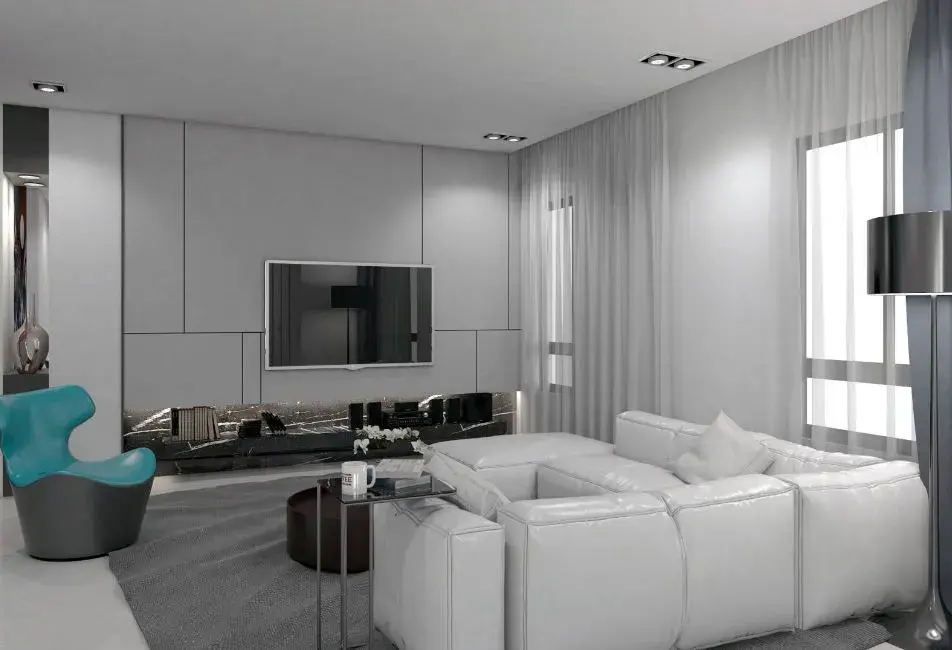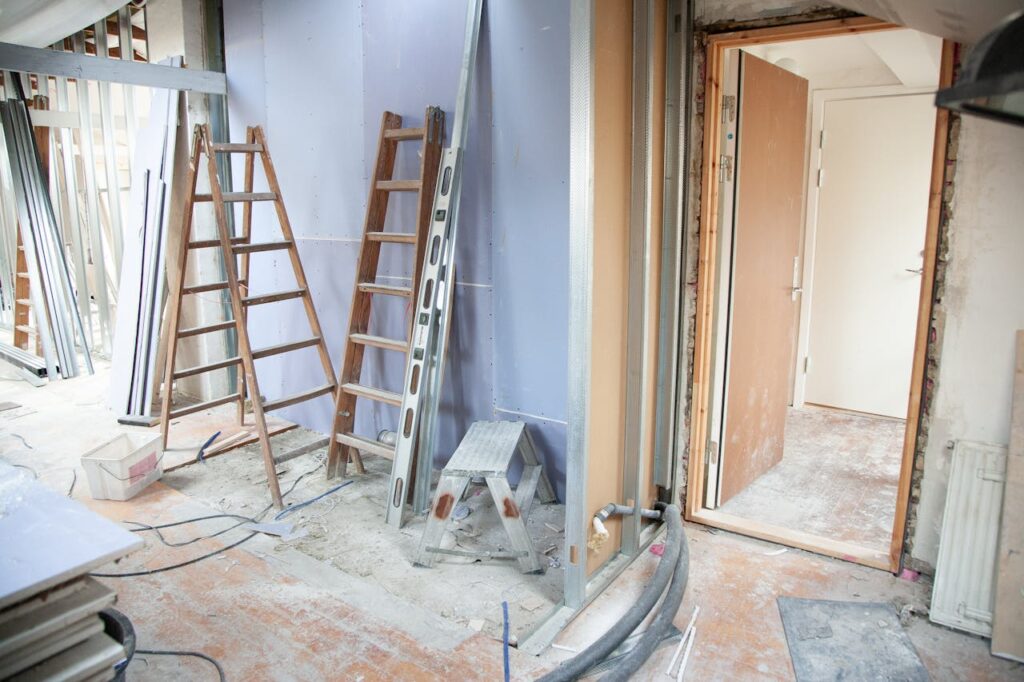As a breath of fresh air sweeps through a cluttered room, so does the philosophy of minimalism cleanse the chaos of modern living spaces.
Minimalism in home remodeling is much like an artist chiseling away at superfluous stone to reveal a sculpture’s true form; it focuses on stripping away unnecessary elements and honing in on functionality and simplicity, culminating in serene environments that radiate calmness.
This concept has its roots entrenched in post-World War II Western architecture, gaining popularity for its practicality and aesthetic appeal. It presents an antidote to the consumer-driven culture prevalent today by championing less as more.
The implementation of minimalist home remodeling requires a discerning eye and meticulous planning. The process involves careful selection and placement of furniture, strategic use of color schemes, thoughtful incorporation of storage solutions, and an overall emphasis on maximizing space utility while minimizing visual clutter.
Effortlessly blending aesthetics with practicality, this approach aims at creating tranquil interiors that not only serve functional needs but also cater to psychological wellbeing. It fosters a sense of belonging among residents by crafting spaces that mirror their preferences and lifestyles rather than merely following transient trends or amassing objects.
Understanding Minimalism in Home Remodeling
In the realm of home remodeling, minimalism can be likened to a tranquil lake: its simplicity and clarity radiate serenity, embodying an aesthetic that values functionality and eliminates unnecessary elements.
This approach to design has roots in the post-World War II art movement that favored pared-down forms and a restrained palette, a stark contrast to the ornamental excesses of previous eras.
As it pertains to interior design and home renovation, this philosophy translates into streamlined spaces where every item serves a purpose. High-quality materials are chosen for their durability and natural beauty rather than embellishment or ostentation.
The hallmarks of minimalist home remodeling extend beyond mere aesthetics or stylistic preferences; they penetrate deeper into the ethos of mindful living.
Minimalist architecture asserts itself through clean lines, open floor plans, ample natural light, understated color schemes, and most importantly, uncluttered spaces devoid of extraneous details or adornments.
This unencumbered style is not merely about creating visually appealing interiors but seeks to foster an environment conducive to tranquility and mental clarity by reducing visual noise.
When applied with discernment, such thoughtful design choices can engender feelings of belonging – transforming an impersonal house into a serene sanctuary where one feels intuitively at ease.
Without the clutter competing for attention or the burden of superfluous possessions weighing down on them mentally or physically, inhabitants can experience peace within these carefully curated environments.
Embracing minimalist remodeling requires a paradigm shift from accumulating decor for its own sake towards intentional selection based on function — with each furniture piece or decorative element justifying its place through utility as well as aesthetic appeal.
The resultant dwelling places serve not only as functional homes but also as catalysts for personal growth; they afford occupants opportunities for introspection and rejuvenation in an otherwise frenetic world consumed by materialistic pursuits.
How to Implement Minimalist Home Remodeling
Delving into the practice of minimalist home remodeling necessitates a profound comprehension of several critical facets.
This includes the process of decluttering, which involves eliminating non-essential items to create a clean and uncluttered space.
Selecting functional furniture that serves multiple purposes while maintaining aesthetic appeal.
Introducing a neutral color palette to cultivate an environment characterized by tranquility and simplicity.
Furthermore, it encompasses the incorporation of minimalist decor that accents rather than overwhelms the space.
As well as consistent maintenance to preserve this minimalistic approach over time.
Decluttering Your Space
Embracing a minimalist approach to home remodeling often begins with the crucial step of decluttering your space, a process that not only transforms the physical environment but also fosters mental clarity and tranquility. This endeavor, while seemingly daunting at first, is an essential component for achieving a serene, minimalist aesthetic. The objective is to remove excess items and retain only those which serve a purpose or bring genuine joy.
This task can be viewed as an opportunity to reassess one’s material possessions and their necessity in one’s life, leading to reduced visual noise and creating more room for thoughtfully selected elements that contribute to the overall design.
Here are three practical steps towards effective decluttering:
1. **Inventory**: Begin by taking stock of all items within each room. A detailed inventory will help identify redundant items, revealing opportunities for simplification.
2. **Systematic Purging**: Adopt a systematic approach in deciding what stays and what goes. Consider functionality over sentimentality; if it does not serve a purpose or bring happiness, it likely isn’t necessary.
3. **Organized Storage**: For retained items, proper organization is key to maintaining the clean lines characteristic of minimalist design.
Indeed, these steps embody much more than mere housecleaning: they represent active decisions about how one chooses to live – in simplicity rather than cluttered complexity – fostering both spatial freedom and mental serenity in one’s living environment.
Choosing Functional Furniture
Once the clutter is effectively minimized, it becomes essential to prioritize functionality when selecting furniture for the now streamlined space. This approach necessitates a shift in perspective from viewing furniture merely as decorative accessories towards recognizing them as functional fixtures that serve specific purposes and enhance overall spatial efficiency.
The concept of multifunctionality should be central to this selection process; pieces that offer multiple uses or can easily adapt to different situations are ideal. For instance, an ottoman that doubles as storage or a coffee table, or a bed designed with drawers underneath. Emphasis should also be on quality and longevity, prompting choices of durable materials and timeless designs that resist fleeting trends.
When choosing functional furniture for minimalist home remodeling, consideration must also be given to how these pieces interact with the space they inhabit. Furniture should not overpower but instead harmoniously blend with the surroundings while maintaining its utility. Attention to scale is crucial here; oversized furnishings can disrupt balance and create visual clutter, negating initial decluttering efforts. In contrast, appropriately sized items contribute positively to spatial flow and serenity.
Incorporating elements such as color and texture strategically can further enhance harmony within the interior environment while maintaining simplicity associated with minimalism ethos – ultimately fostering a sense of tranquility and belonging in the redesigned living spaces.
Selecting a Neutral Color Palette
Navigating the sea of color choices for your interior space, one might wonder if the minimalist’s favored hues – neutral ones – are a mere running out of imagination or a calculated strategy. However, this notion could not be further from the truth.
The use of neutral colors in minimalism is an intentional and strategic design choice that aims to create a calm and serene environment within one’s living spaces. This aesthetic principle reflects the core philosophy of minimalism: reducing distractions and focusing on essential elements.
A well-chosen palette of neutrals can provide a visually harmonious backdrop that encourages serenity while also allowing room for flexibility in decoration.
The selection process for neutral color palettes revolves around three key principles:
1. **Simplicity**: When selecting colors, it is crucial to maintain simplicity as excessive variation can lead to visual chaos rather than tranquility.
2. **Versatility**: Neutral shades offer versatility due to their ability to blend seamlessly with various textures, patterns, and finishes.
3. **Balance**: In addition to being versatile and simple, neutral colors promote balance by creating a sense of harmony between different elements within a room.
These guiding principles ensure that despite its seemingly limited scope, choosing a neutral palette offers numerous opportunities for creative expression without compromising on the minimalist ethos. It allows homeowners to create an inviting space that provides respite from daily stresses while also subtly satisfying their need for belonging through shared aesthetic values present within minimalist design philosophy.
Incorporating Minimalist Decor
Transitioning from a neutral color palette, the next step in minimalist home remodeling is incorporating minimalist decor.
This aspect further embodies the ‘less is more’ philosophy and contributes to creating a serene living space.
Minimalist decor focuses on simplicity, functionality, and subtlety.
Instead of overwhelming spaces with numerous decorative pieces, this style encourages thoughtful selection and placement of fewer items that hold significant aesthetic or functional value.
Such an approach could involve choosing one standout artwork rather than filling every wall space with pictures or opting for furniture pieces with clean lines and minimal detailing over ornately designed ones.
The use of natural materials such as wood, stone, or metal can also enhance the sense of calmness while adding texture to the room without resorting to excessive ornamentation.
The incorporation of minimalist decor extends beyond physical objects to incorporate spatial elements like light and open spaces.
By allowing plenty of natural light into rooms through large windows or glass doors, a feeling of spaciousness is created which contributes towards serenity.
Similarly, maintaining uncluttered spaces by minimizing furniture and accessories helps avoid visual noise that can lead to feelings of stress or discomfort.
Thus, through strategic choices in both physical decorations and spatial arrangements, minimalist home remodeling enables dwellers to cultivate peaceful surroundings that promote relaxation and mental well-being.
Maintaining a Minimalist Home
Maintaining the simplicity and functionality of a space adhering to the philosophy of minimalism involves regular decluttering, systematic organization, and thoughtful acquisition of new items.
The successful preservation of a minimalist home requires an ongoing commitment to curation and careful management of possessions.
Regular decluttering is instrumental in eliminating unnecessary items that clutter space and disrupt the serenity associated with minimalistic design.
This may involve disposing, donating or selling items that no longer serve a purpose or bring joy.
Systematic organization goes hand-in-hand with decluttering – it includes arranging objects in aesthetically pleasing ways that enhance functionality while maintaining visual balance.
Engaging in conscious consumption plays an integral role in preserving the minimalist aesthetic, ensuring every item brought into the home serves a distinct purpose or brings significant value.
Thoughtful acquisition extends beyond utility; it also considers environmental impact by favoring quality over quantity, thus reducing waste generation and consumption patterns detrimental to ecological sustainability.
A minimalist home is not simply defined by what is removed but also by what remains – each object carefully selected for its function as well as aesthetic contribution to the overall harmony and tranquility of the environment.
Such strategic preservation nurtures a sense of belonging among inhabitants who find solace in their orderly surroundings resonating with calmness amid life’s inevitable chaos.
Rustic Elegance: The Enchanting World Of Farmhouse Remodeling
Designing The Next Chapter: Home Renovation For A Brighter Future




